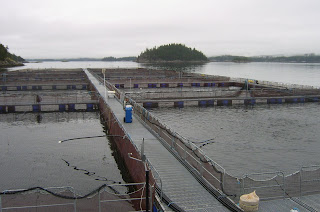Phytoplankton Needs
Remember phytoplankton are plants and plants need sunlight as well as nutrients.Sunlight is needed for photosynthesis, this gives the cells the energy needed for cell growth and division.Phytoplankton need to take in nutrients from the water in order to grow. All species need phosphate and nitrogen and other elements like silicates, iron and sulphates. These nutrients are put into the surface waters from land run-off or by upwelling of high-nutrient deep water.
Plankton Growth
Factors that could influence plankton growth are water column stratification, species compitition and vertical migration as well as a trick called allelopathy. The water column is considered stratified when there is two or more distinct layers. The salinity of the ocean varies anywhere from 0 to 35 ppt (parts per thousand). Normally the salinity is 25-30 ppt. Fresh water when warmed by the sun will sit on top of heavier salt water. When water is stratified there is little or no mixing in the water and plankton can position themselves in the sunnier water for optimal growth. Some phytoplankton (like heterosigma) can swim through the water column using flagella to get the nutrients they need for growth. Many phytoplankton can only divide once per day, others like Heterosigma can divide up to five times per day. Allelopathy is when a species produces substances that kill or retard the growth of other plankton, taking over the water column once again like Heterosigma.
Harmful Concentrations of Plankton
Chaetoceros can be harmful to fish in concentrations of 25-30 cells/ml. Corethron Hystrix can be harmful at levels of 500cells/ml. There have been blooms of Corethron Hystrix with concentrations of 800 cells/ml that have had no mortalities. If more than 20 cells/ml of Heterosigma are seen there is soon to be cause fro concern. Concentrations have reached 100,000 cells/ml. Chattonella have killed fish with low concentrations of 50 cells/ml. Dictyocha have killed salmon in concentrations of 100 cells/ml. Alexandrium Catenella can be deadly to fish as well as humans. It causes PSP (paralytic shellfish poisoning). May be harmful to fish at higher concentrations like 500 cells/ml. 2000 cells/ml of Cochlodinium or or Gymnodinium will kill fish.
Fishfarmer Protocols
Fishfarmers are trained to sample, identify and count harmful plankton. Plankton tows are done instead of discrete samples to determine the initial presence of harmful species. Water samples are taken daily from three depths, 1 meter, 5 meter and 10 meter. Rafter slides are prepared and scanned for harmful plankton. The most dominate species is noted as well as any harmful plankton counts. Environmental conditions are also recorded daily.
In conclusion
Plankton blooms are a natural occurrence in all the oceans. Microscopic organisms survive in the water as well as on the land. Once a bloom occurs around a fishfarm, there is very little a farmer can do. Don't feed, turn on air compressors for bubble mats and in some situations tarping an entire farm are some things that can be done to minimize mortality. It is a sad thing when a Heterosigma bloom kills off half or more of the fish you worked so hard to grow.




